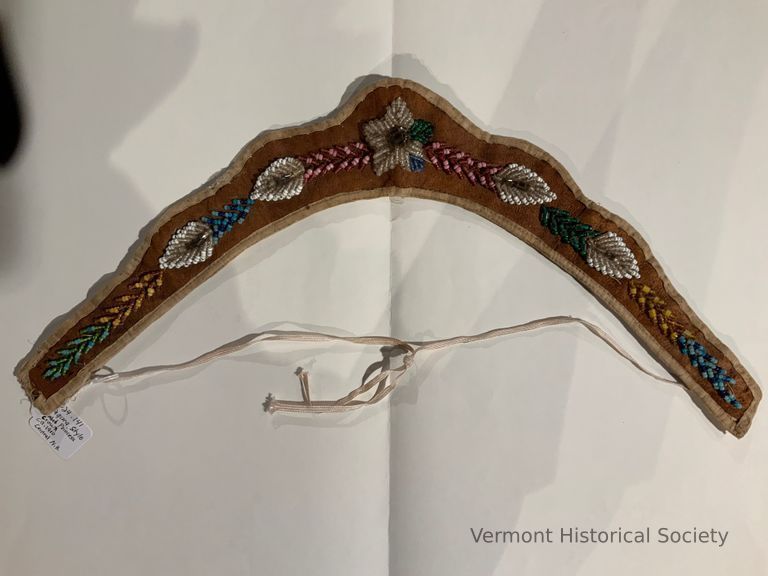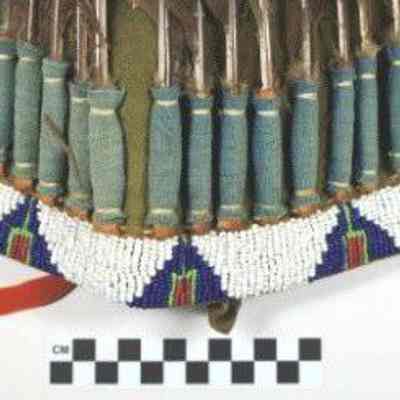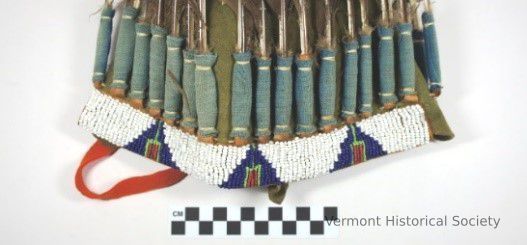112/11/D6
Search This Category


Beaded Crown
Name/Title
Beaded Crown
Lexicon
Description
Niagara-style "Princess Crown." Brown fabric with buff tape. Beaded central flower/star flanked by stems and leaves.
Use
Produced for the Degree of Pocahontas social organization, may have been worn by Wabanaki woman.
Made/Created
Date made
circa 1910
Entry/Object ID
L2024.3.141
Context
This Niagara-style beaded “princess crown” labeled “Central NH,” on the tag, was produced in large quantities as costume for the Degree of Pocahontas woman’s social organization. However, we also have photos of them worn by Wabanaki women as well. The main evidence for Native use is its condition. Every piece of Degree of Pocahontas costuming I have seen is in pristine condition, except when later used as Halloween costuming, which rapidly detaches the bead-work. This example shows continual, not episodic use wear consistent with years of careful use.


Headdress
Name/Title
Headdress
Lexicon
Clothing/Dress/Costume Details
Article of Clothing/Dress/Costume
Headdress
Textile Details
Leather
Material
Whipstitch
Running Stitch
Description
Loom-beaded head band. The band is made of tiny glass beads woven into a design of feathers, chevrons, and Xs in purple, white, and black. The beaded strip is stitched onto a leather backing, which is stretched thin at either end to make ties.
Acquisition
Accession
2017.3
Ethnography
Relationships
Related Person or Organization
St. Francis, Homer (1935-2001)
Person or Organization
Related Places
Place
Swanton
Town
Franklin County
County
Vermont
State/Province
United States of America
Country
North America
Made/Created
Date made
circa 1950
Dimensions
Dimension Description
Overall
Entry/Object ID
2017.3.13
Context
This was Abenaki chief Homer St. Francis' first head dress.


Headdress
Name/Title
Headdress
Lexicon
Clothing/Dress/Costume Details
Article of Clothing/Dress/Costume
Headdress
Textile Details
Feather
Felt
Beads
Material
Clothing Sex
Male
Description
a. Feathers attached to green felt cap with blue feather "wraps." White, blue, green, and red beaded browband. Red ribbon chin strap.
b. cotton bag
b. cotton bag
Acquisition
Source (if not Accessioned)
Abenaki Cultural Conservancy
Made/Created
Date made
circa 1930
Entry/Object ID
L2024.3.164a-b
Context
This heavily worn headdress is a mix of well-done beadwork and naïve, culturally inappropriate details like the feather wraps and the crude felt side pendant drops. Later correspondence with the dealer indicated that it “came from a picker out of Raymond (on the shores of Sebago Lake), Maine.” This may be an example of period “Indian Enthusiast” art, perhaps from a children’s camp at the Lake. However, this item saw long sustained use and expedient (inexpert) repair that is generally not characteristic of enthusiast wear. There are records of Native people making and wearing native clothing during this period, and this is probably an example of that tradition. Local Native People also would don “Indian Clothes” for performance or selling crafts at tourist areas like Sebago Lake. It comes with its original cotton drawstring bag. This is the type of adult headdress that appears in 20th century “Blanket and Headdress” photographs of Western Abenaki Men (see 2024.3.154).


Headdress
Name/Title
Headdress
Lexicon
Description
Beaded, leather and turkey feather headdress. Band decorated with star/flower motifs in beadwork.
Acquisition
Source (if not Accessioned)
Abenaki Cultural Conservancy
Made/Created
Date made
circa 1910
Entry/Object ID
L2024.3.123
Context
Feathers all broken replaced 2001. Headdress is a bit of a mystery. It was sold to Frederick Wiseman as “from an old Indian family” by a Western Maine antique dealer. Its style is unique, with beautiful tiny edge beading with coarse springperlen Bohemian beads making star designs. There is a chance that this was made by an “Indian hobbyist” in the 1910’s or 1920’s.